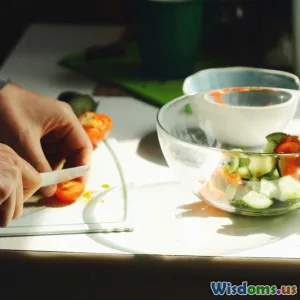
Meal Planning App Challenges No One Warns You About
15 min read Discover the hidden hurdles of meal planning apps, from personalization blocks to integration pitfalls, and how to overcome them for long-term meal prep success. (0 Reviews)
Meal Planning App Challenges No One Warns You About
Meal planning apps sparkle with promises: effortless organization, streamlined grocery lists, and healthier eating habits, all in your pocket. Yet, beneath these appealing features lurk hidden struggles users seldom discuss. If you've eagerly downloaded a meal planning app only to find yourself frustrated or backsliding to old habits, you are not alone. Let's pull back the curtain on the lesser-known challenges of meal planning apps—what no one’s talking about, but everyone needs to understand for lasting food freedom.
The Allure—and the Reality—of Meal Planning Apps
From Pinterest-perfect planners to AI-powered culinary tools, the explosion of meal planning apps offers something for everyone. The global meal planning apps market was valued at approximately $2 billion in 2023 and is projected to grow at 12% annually, fueled by wellness trends and digital convenience. Millions seek these apps as lifelines—whether aiming to save money, eat better, manage food intolerances, or simply keep their week on track amidst chaos.
But here’s the catch: After the honeymoon phase, many users abandon their slick new app as obstacles arise beneath the surface. It’s not a lack of willpower—it’s the result of challenges that often go overlooked in flashy marketing.
1. Personalization: The Promised Land That’s Hard to Reach
Promise: "Tailor your meal plan to fit your unique lifestyle!"
“Meal planning apps never seem to ‘get’ me, no matter how many preferences I input.” — Sophie Y., busy parent and former app devotee
Modern apps claim to customize your entire culinary life—but the reality is rarely so seamless. Behind the algorithms, there are significant limitations:
- Dietary Nuances Are Often Overlooked:
- Most apps let you flag basic diets (vegan, paleo, gluten-free), but what if you’re gluten-intolerant with a peanut allergy, hate mushrooms, and want two vegetarian lunches per week? The layers of specificity many people need simply don’t exist.
- Cultural Food Preferences Get Lost:
- Templates skew Western with little representation for global cuisines or cultural traditions, making it tough for users craving diversity.
- Seasonality and Local Ingredients:
- Apps rarely adjust for what’s actually available locally or in-season.
Example: The Nuance Gap
Sarah, a user from Texas, shared that every week, her app suggested meals with kale and artichoke. “It’s the middle of summer. These are expensive and the quality’s poor here! Why can’t the app just ask if produce is in season near me?”
Possible Solution
Look for apps with advanced filtering and regional ingredient options, or augment your digital plan with local farmers’ market calendars and your instinctual knowledge.
2. Integration Overload (or Underload): Bridging Digital Gaps
Many apps aim to serve as command centers for your dietary life—but unless they seamlessly integrate with your habits and tools, friction is inevitable.
- Grocery Delivery Woes:
- Some premium apps offer partnered grocery delivery, but store selections are often limited. Substitutions may not respect dietary restrictions, creating food waste and frustration.
- Kitchen Inventory Disconnect:
- Apps that claim pantry-sync features are often foiled by irregular shopping habits or mislabeled inventory. “Half the time, it tells me we have eggs left because I forgot to mark them used,” says Malik P., a single dad.
- Fitness, Wearables, and Calorie Tracking
- Integration with other health apps (fitness trackers, smart scales) is often clunky or incomplete, leading to data gaps. According to a 2022 survey by Health App Review, users ranked “poor app integration” as one of their top 3 reasons for discontinuing use.
Example: Grocery List Chaos
After connecting a meal app to an online grocery service, Emily received pumpkin puree for three weeks in a row—even though she only needed it once. “The app didn’t track leftovers or partial cans. I wasted money and food.”
Possible Solution
Leverage manual review—before hitting ‘order,’ cross-check the list with your actual pantry. For deeper integration, seek out apps that routinely update and partner with regional services.
3. Decision Fatigue and Menu Monotony
Scheduling every meal in advance can seem liberating at first, but meal planning can paradoxically lead to exhaustion or boredom—a well-documented phenomenon in behavioral psychology.
- Too Many Choices:
- Apps may present hundreds of recipes without helpful filtering, overwhelming users instead of inspiring them.
- Menu Repetition:
- Alternatively, basic free plans suggest the same set of meals repeatedly. One 2021 study found that users abandoned meal planning apps most frequently due to “recipe boredom.”
“If I have to eat the same chicken salad again, I’m deleting this app!” — Anonymous user feedback
Example: Recipe Roulette Gone Wrong
Carlos set up his macros and requested high-protein dinner ideas. The app filled his week with grilled chicken, rice, and broccoli—six different recipes, yet fundamentally the same meal. “It was healthy, sure, but where’s the joy in eating?”
Possible Solution
Treat app suggestions as a starting point and stay flexible—rotate in personal favorites and experiment with global cuisines even if it means modifying the auto-generated plan.
4. Time-Tracking and Real-Life Constraints
Meal planning apps generally assume you’re a home cook with hours to spare—a rosy ideal compared to modern daily realities.
- Unrealistic Preparation Times:
- Recipe times are notoriously unreliable. In a user survey (Meal Prep Tech, 2023), 67% reported that actual cooking time was “[at least] 10-20 minutes longer than the recipe promised.”
- Ingredient Sourcing:
- Gourmet ingredients or specific spice blends aren’t easily found between school runs or after late workdays.
- Special Dietary, Family, or Work Needs:
- Feeding picky kids, managing shift work meal breaks, or navigating communal living all add complexity the apps don’t always cover.
Example: Weeknight Woes
Devin’s app scheduled a 35-minute lamb curry on his busiest night, not factoring in that Wednesday is also soccer practice. Translation: takeout pizza, again.
Possible Solution
Pair app planning with your calendar and acknowledge the need for ‘plan B’ staples—quick meals or healthy freezer options ready for the truly hectic days.
5. The Mental Load: Motivation Slumps and Guilt Loops
The psychological weight of ‘sticking to the plan’ can sour your meal prep journey.
- App-Induced Guilt:
- When you miss a day or deviate from the plan, notification reminders can feel less like a cheerleader and more like an admonishing coach. “Missed lunch prep! Let’s do better tomorrow”— sometimes it stings more than it motivates.
- Motivation Slumps:
- Relying solely on apps for inspiration leads to burn-out or apathy, especially during busy or emotionally charged life seasons.
- Perfection Traps:
- Many users feel compelled to follow the plan exactly, disregarding shifting appetite, moods, or changes in schedule.
Example: The App as Taskmaster
Marina, who started with high hopes, eventually deleted her meal planner after anxiety around ‘failing’ her plan took a toll: “I realized I was more stressed trying not to mess up than I was before I started.”
Possible Solution
Embrace imperfection and use the app as a flexible guide rather than an unyielding rulebook. Build in ‘off’ days and cultivate a judgement-free approach to deviations.
6. Data Privacy and Information Overload
With personalization comes the cost of surrendering personal data. Additionally, more data points can—paradoxically—paralyze decision-making.
- Privacy Concerns:
- Apps requiring detailed health or dietary histories raise questions about data security, particularly given high-profile breaches in health and fitness sectors (e.g., the 2020 MyFitnessPal breach affecting 150 million users).
- Analytics Overwhelm:
- Calorie and nutrition trackers can flood you with charts and feedback, complicating meal choices or sparking food obsession in those prone to disordered eating patterns.
Example: Tracker Fatigue
Joan found herself spending more time reading analytics than actually cooking. “It started to feel like homework. I just wanted to make dinner, not earn a nutrition Ph.D!”
Possible Solution
Prioritize apps with strong privacy statements, opt for selective data sharing, and consider turning off granular analytics if it detracts from the enjoyment of food.
7. Accessibility and Inclusivity Gaps
Despite remarkable advances in app technology, many platforms remain frustratingly inaccessible to users with disabilities, or uninformed about socioeconomic diversity.
- Interface Accessibility:
- Not all apps feature voice guides, text size adjustment, or compatibility with screen readers.
- Economic Realities:
- Price-yielding recipes or premium subscriptions may be unfeasible for budget-strapped users. A meal plan based on salmon and pine nuts is less helpful for the average family than a budget-friendly bean chili.
- Family Diversity & Food Insecurity:
- Apps often assume solo users or traditional households, overlooking multi-generational family living or food scarcity issues.
Example: Budget Blindness
Rosalia, a single mother, gave up on an app that promised 'budget meals'—yet routinely suggested $9 blocks of cheese and out-of-season produce. She comments, “It’s like they want me to have a Whole Foods budget, but I only have an Aldi budget.”
Possible Solution
Champion accessible design and advocate for apps that allow flexible ingredient swaps, customizable scales, or community-driven resources for more inclusive meal planning.
8. One Size Doesn’t Fit All: Diversity of Lifestyles
Meal planning is not a one-size-fits-all endeavor, no matter how advanced the algorithms become.
- Varying Culinary Skills:
- Some apps assume users are kitchen beginners, while others leap straight to advanced boning and braising techniques.
- Serendipity versus Structure:
- Some personalities thrive on spontaneity and resist the rigidity a set meal plan brings.
- Changing Life Circumstances
- Pregnancy, medical diagnoses, bereavement, or schedule changes may all swiftly alter what's realistic—and apps aren't always agile enough to handle these pivotal moments.
Example: Personality Mismatch
Derek, who loves impromptu cooking with whatever's on hand, found meal planning “sucked the joy and creativity out of half my week.” Others, with strict health routines, bemoaned lack of granular nutrition tracking.
Possible Solution
Customize how you use the app—embrace suggested structures that work and ignore or tweak the rest to suit your evolving lifestyle. Sometimes, pen, paper, and intuition are the best supplements.
Conclusion: Smarter Meal Planning for Real Lives
Meal planning apps remain powerful allies for many, but their magic is not automatic. Recognizing the hidden—and surmountable—challenges helps you set realistic expectations and stay the course.
- Flexibility is Essential: Treat any app as just one tool in your meal prep arsenal, not gospel.
- Data Isn't Destiny: Use digital insights as guards rather than jailers; don’t let numbers dictate enjoyment.
- Stay Inspired: Rotate recipes and bring in real-world favorites.
- Customize Ruthlessly: No app knows you better than you do—dynamic adaptation is key.
Action Step: Audit your current app setup. Where do you feel friction? Experiment with blending old-school tricks (sticky notes, books, shared calendars) with app-based plans, and don’t be afraid to reassess or switch platforms entirely.
Final Thought: Meal planning isn’t just about what’s for dinner—it’s about building a sustainable, healthy relationship with food that fits your unique rhythm of life. Know the pitfalls, and you’ll be empowered to make technology work for you—not the other way around.
Rate the Post
User Reviews
Popular Posts


















